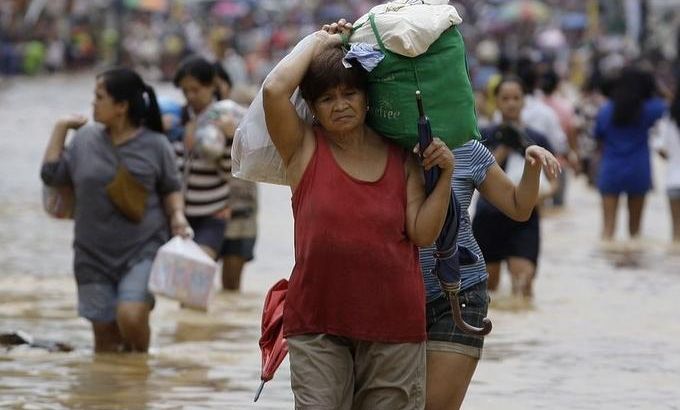Floods submerge most of Philippine capital
Emergency workers rush food, water and clothes to more than a million people displaced and marooned in Manila.

Tens of thousands of people are being evacuated from the capital of the Philippines as floods devastate the city.
About 80 per cent of Manila, a sprawling metropolis of about 12 million people, remained inundated on Wednesday, Benito Ramos, head of the national disaster agency, told Reuters news agency.
Keep reading
list of 4 itemsLost Futures
Photos: Greek valley that became a lake stirs drought debate
Botswana threatens to send 20,000 elephants to Germany
“The roads in some areas are like rivers. People have to use boats to move around. All the roads and alleys are flooded,” Ramos told AFP news agency.
Emergency workers and troops have rushed food, water and clothes to nearly 800,000 people displaced and marooned from deadly floods spawned by more than a week of southwest monsoon rains that soaked the Philippine capital and nearby provinces.
“We’re still on a rescue mode. Floods are receding in many areas but people are still trapped on their roofs,” Ramos said.
Financial markets reopened after being shut on Tuesday, but schools and many businesses remained shut for a second straight day with the military, police and civic officials struggling to deliver aid.
Still, many people were reluctant to leave flooded homes, fearing a loss of valuables, officials said.
“We’re also asking people living along swollen riverbanks to evacuate,” Ramos said. “If there is a need for us to force them to leave their homes, we will do that for their own safety.”
The death toll in Manila and nearby provinces stood at 19, including nine members of one family who died in a landslide.
Al Jazeera’s Marga Ortigas in Manila said that while the government is working around the clock in its rescue efforts, many are still left stranded.
“There are people who are actually tweeting from the rooftop of their homes to say that no help has yet reached them,” Ortigas said.
“There are others who are calling into radio stations and putting their plea out to national rescuers.”
Ortigas added that a volunteer “Twitter brigade” is using the social medium platform to try to organise relief and get medical attention to where it’s needed.
Slums hardest hit
The worst hit parts of Manila were mostly the poorest districts, where millions of slum dwellers have built homes along riverbanks and other areas susceptible to flooding.
In Santo Domingo, a creekside shantytown, mother-of-three Anita Alterano recounted how her family escaped the floods that had submerged their one-storey home by walking over the roofs of houses until they reached high ground.
“We initially just decided to climb up on the roof where we were safe but wet. We waited for rescuers but it took so long for anyone to notice us,” Alterano told AFP.
“So we got a rope, I tied myself to my husband and my children, we clambered from roof-to-roof … until we reached a school. But the problem is we have no water and food.”
Even some of Manila’s richest districts were affected, including the riverside community of Provident where water had completely inundated the ground floors of three-storey mansions.
Inside the gated village of about 2,000 homes, rescue workers on a motorised rubber boat drove past submerged luxury cars to retrieve children and the elderly from rooftops.
Back to work
On Wednesday, the weather bureau lifted the rainfall alert level even as the volume of rainfall in the last 24 hours rose to 390 mm from 323 mm in the previous day.
The highest recorded 24-hour rainfall was 454 mm in September 2009, inundating 80 per cent of the capital and resulted in the death of more than 700 people and destruction of $1 billion worth of private and public property.
Across Manila and surrounding areas, more than 800,000 people had sought help from rescue workers, according to the National Disaster Risk Reduction and Management Council.
Nearly 86,000 of them were sheltering in schools, gymnasiums and other buildings that have been turned into evacuation centres, while others were staying with relatives and friends, the council said.
But after much of the city was paralysed on Tuesday, the government ordered government and private sector employees back to work, while the stock market resumed trading.
The death toll has gone up to 69 since steady rains started when Typhoon Saola hit northern portions of the main Luzon island in late July.
The Philippines endures about 20 major storms or typhoons each rainy season, many of which are deadly.